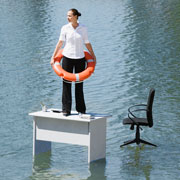9 min read
6 Year-End Small Business Tax Saving Tips
There's still time for small businesses and their owners to implement strategies to save taxes for 2025. Traditional...
Submitted By: Julie Miller on Apr 27, 2021 9:05:10 AM
 Weather emergencies take many forms, and depending on your location, you’re likely more vulnerable to some forms than others. But the following data about the business impact of natural disasters from the Federal Emergency Management Agency (FEMA) is a wake-up call:
Weather emergencies take many forms, and depending on your location, you’re likely more vulnerable to some forms than others. But the following data about the business impact of natural disasters from the Federal Emergency Management Agency (FEMA) is a wake-up call:
FEMA suggests a comprehensive five-step process for protecting your business from natural disasters, such as hurricanes, floods, tornados, earthquakes and fires.
1. Program Management
This step entails two key tasks:
Your goals may be straightforward, such as protecting the safety of your employees, mitigating risks of physical damage and getting back to business as soon as possible. But, to come up with a sound plan, you’ll need to get more granular.
For example, how quickly do you need to resume operations to avoid long-term damage to your business? The disaster recovery plan you’d need to create to be able to resume operations within a day (or even a few hours) will look different from a plan that would have you back on your feet within a week or two.
Also, if your goals include managing any legal liability related to a weather disaster, you may need to include legal advice when putting your plan together. Similarly, if your plan will involve managing the financial risks of a weather-related emergency, consider adding an insurance professional to your planning team for advice and periodic coverage review.
2. Plan Creation
Next in FEMA’s five-step process is assembling the plan itself. Begin by cataloging all the kinds of risks you face so that you can address and prioritize them. Some examples are:
Your plan may include:
An effective contingency plan for weather emergencies naturally needs to be comprehensive. But it shouldn’t be so detailed that it becomes overwhelming and difficult to comply with and keep it updated.
3. Plan Implementation
Elements of your plan will require action to put it in place. Examples include:
When reviewing your potential risks, you also might discover that a weather emergency reveals a need for additional emergency exits. If so, follow through by creating those exits.
4. Testing and Exercises
There’s a reason schools have fire drills and armies have military exercises on a regular basis. The strength of a weather emergency plan lies in what happens when a real emergency occurs. But practice makes perfect—or at least better.
Although a priority, tests shouldn’t be limited to how quickly people get out of harm’s way. You should also use periodic testing to determine whether the other safeguards you put in place, such as safety equipment and backup storage for vital business records, are fully operational.
5. Program Improvement
Ideally, it won’t take an actual weather emergency to determine whether your plan is sound and comprehensive. Some weaknesses may be exposed during the process of simulating a crisis. But others might not be fully apparent at that stage. Your original plan, even if well-executed in a test, might lack important elements.
Similarly, as time goes by, conditions may change in your business operations, rendering your plan inadequate. In addition to improving your emergency response plan based on any shortcomings revealed in a drill, take a fresh look at your plan at the end of each year to ensure that it will still provide the protection you need.
Final Thoughts
Keep in mind, even if you never sustain serious damage in a weather emergency, having a sound plan in place could result in savings on your business insurance. And you might also sleep better at night.
9 min read
Dec 3, 2025
There's still time for small businesses and their owners to implement strategies to save taxes for 2025. Traditional...
4 min read
Dec 1, 2025
Given the dramatic increase in the federal gift and estate tax exemption over the last 20 years, there's a common...